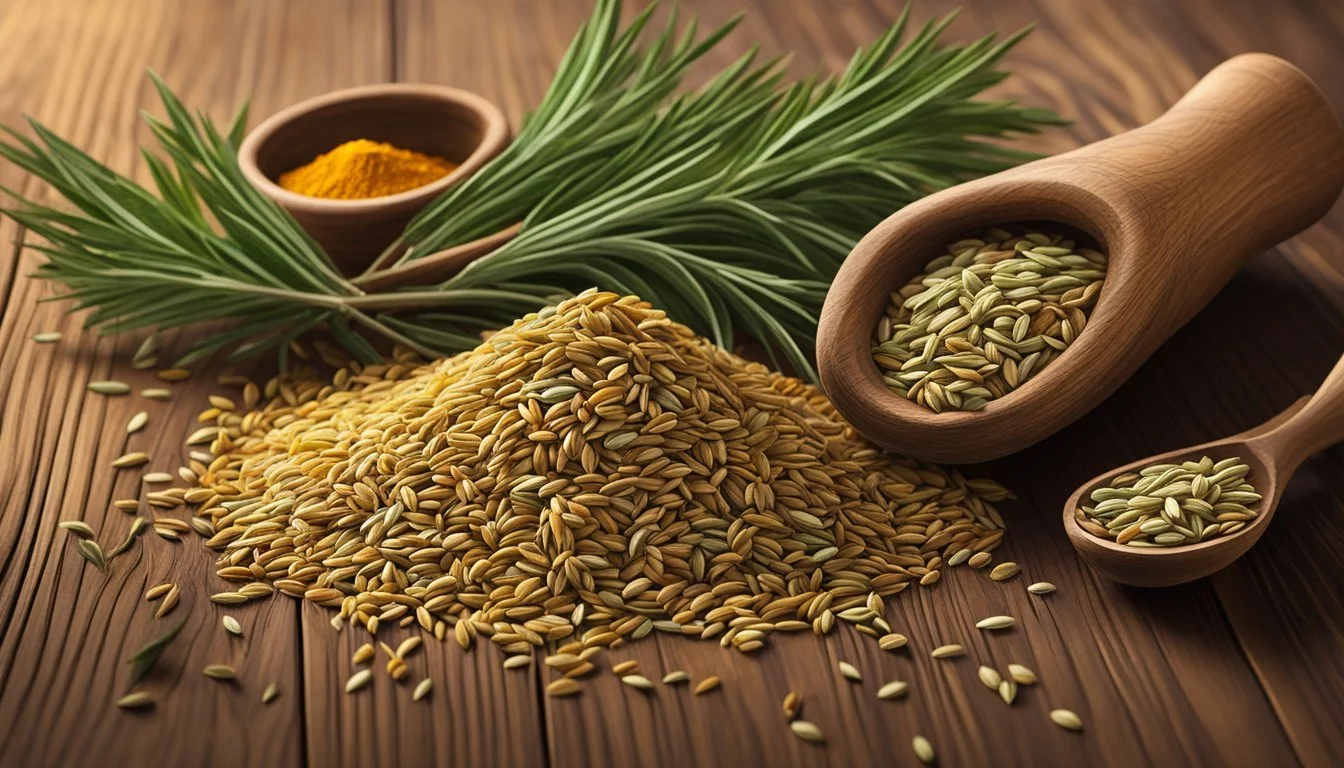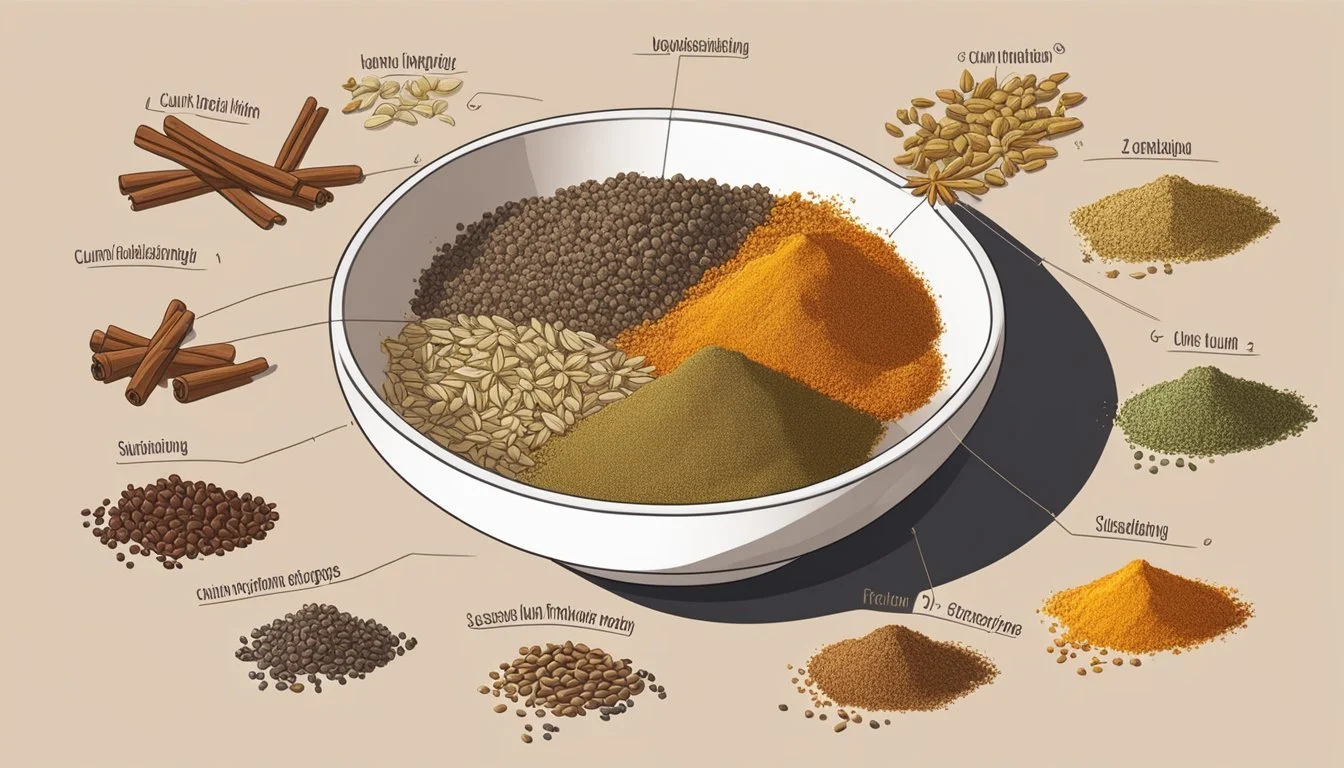Cumin Substitutes
Top Alternatives for Your Spice Rack
Cumin is a staple spice in many cuisines, from Mexican and Indian to Middle Eastern, imparting a distinctive warm and earthy flavor to dishes. Its nutty, peppery taste is integral to spice blends such as taco seasoning, garam masala, and curry powder. When cooking, finding a suitable substitute for cumin is essential if it's unavailable or if someone prefers to avoid it for dietary reasons.
Several spices can mimic the flavor profile of cumin or complement the overall taste of a dish where cumin is absent. Ground coriander, for example, is a common alternative. It offers a citrusy hint while belonging to the same plant family, making it a useful cumin stand-in. Caraway seeds, which share similarities in appearance and taste with cumin, can also be used, though they have a more potent flavor, thus requiring adjustment in quantity to strike the right balance in recipes. Other substitutes, such as curry powder, contain cumin within their blends but can provide a comparable warmth and complexity to dishes. Each substitute offers a unique twist and should be chosen according to the desired outcome of the dish being prepared.
Understanding Cumin and Its Significance
Cumin is a pivotal spice that imparts an earthy, warm flavor and aroma to dishes across various cuisines. Its role goes beyond taste, as it also contributes to the signature profiles of different regional foods.
The Basics of Cumin
Cumin derives from the seeds of the Cuminum cyminum plant. The seeds are generally small, oblong, and tan-colored. They can be used whole or ground into powder. Their distinctive earthy and slightly bitter flavor is often described as penetrating and warm, which can lend a depth of complexity to a myriad of dishes.
Culinary Uses of Cumin
In the culinary world, cumin's robust flavor makes it a versatile spice. Cumin seeds are commonly toasted to enhance their aroma before being ground into a fine powder. This spice can be found in an array of spice blends and is essential in creating the foundational flavors for soups, stews, and marinades. Its pungency complements the profiles of meats and vegetables alike.
Cumin in Different Cuisines
Cumin is fundamental in various regional cuisines. In Indian cuisine, it is a staple ingredient in many spice blends, like garam masala and curry powder, lending a warm and earthy note to curries and other dishes. Middle Eastern cuisine uses cumin to season meats and vegetables, as well as to flavor couscous (What wine goes well with couscous?) and other traditional dishes. In Latin American cuisines, cumin is prized for its distinctive flavor, contributing to the authentic taste of tacos, fajitas, and bean dishes. Its widespread use underscores cumin's importance in global culinary practices.
Common Cumin Substitutes
Cumin has a distinct earthy flavor that is often hard to replicate, but there are several substitutes that can be used in recipes calling for cumin. Those who are in need of a cumin substitute may turn to spices like coriander, fennel seeds, and caraway seeds, each offering a unique flavor profile that can complement various dishes.
Coriander as a Substitute
Coriander, especially ground coriander, shares a citrus-like flavor that resembles cumin and makes for a versatile substitute. For every teaspoon of cumin required, one can use an equal amount of ground coriander to achieve a similar taste profile without the strong earthy notes of cumin.
Fennel Seeds and Anise
Both fennel seeds and anise seeds have a slight licorice flavor, which can add a unique twist to dishes that traditionally call for cumin. They should be used sparingly, as their flavor is sweeter and more aromatic. A good starting point is using half a teaspoon of either fennel or anise to replace one teaspoon of cumin, adjusting as per taste preference.
Caraway Seeds
Caraway seeds are another cumin substitute, offering a slightly bitter, earthy flavor that closely mimics that of cumin. Similar to using fennel and anise, starting with half a teaspoon for every teaspoon of cumin can help maintain the intended flavor of the recipe, and one can adjust to taste if a stronger flavor is desired.
Spice Blends as Alternatives
Spice blends often contain cumin and can serve as effective substitutes when individual spices are unavailable. They bring a complex array of flavors that can complement a variety of dishes.
Substituting with Garam Masala
Garam masala is a warm spice blend traditional to Indian cuisine. It usually includes cumin, along with cinnamon, cloves, cardamom, and other spices. When using garam masala in place of cumin, start with a small amount and adjust to taste due to its multifaceted flavor profile.
Curry Powder
The components of curry powder may vary, but it commonly consists of turmeric, coriander, cumin, fenugreek, and additional spices such as mustard seed and black pepper. Its balanced and savory character makes it a suitable substitute for cumin in dishes, lending both color and complexity.
Taco Seasoning Mix
Taco seasoning mix combines spices like chili powder, paprika, onion powder, and often cumin. While each brand’s blend might differ slightly, using taco seasoning as a cumin substitute infuses dishes with a bold, Southwestern flair. It's especially appropriate for recipes where cumin's warmth is a key element.
Other Spice Mixes
Numerous other mixes can stand in for cumin, such as baharat and ras el hanout, each a staple in Middle Eastern cuisine. Baharat may include paprika, black pepper, coriander, and cumin, while ras el hanout typically has a longer list of ingredients, offering an intricate taste. When replacing cumin with these blends, one should consider the spice level and overall flavor of the recipe to ensure compatibility.
Creating Your Own Cumin Substitute Blend
Creating a personalized cumin substitute blend involves selecting the right spices and ensuring they are ground to release their full flavor potential. This can be especially useful when ground cumin is unavailable or someone wishes to experiment with flavor profiles.
Combining Spices
For a homemade cumin substitute, individuals blend a variety of spices that complement each other. The backbone of such a blend could be:
Ground coriander seeds: Shares the same family with cumin and offers a citrusy flavor.
Ground caraway: Strong and earthy, akin to cumin.
A simple starting ratio for blending could be:
1 tablespoon ground coriander seeds
1 teaspoon ground caraway
Optional: Add a pinch of ground paprika or chili powder for warmth and complexity.
These components are mixed thoroughly to create a balanced and aromatic cumin substitute.
Grinding Whole Spices
The optimal flavor is achieved by using whole seeds and grinding them fresh. To grind whole spices:
Measure out the whole seeds as per the recipe needs.
Place them in a spice grinder or mortar and pestle.
Pulse or grind until the mixture reaches the consistency of ground cumin.
It is essential to note that freshly ground spices are more potent than pre-ground, so individuals may need to adjust the quantities to taste. For instance, they could use a slightly smaller amount of the homemade blend compared to the amount of ground cumin called for in the recipe.
Specialty Substitutes and Exotic Alternatives
When traditional cumin is unavailable, one's quest for unique flavor profiles can be satisfied through specialty and exotic substitutes. These alternatives offer their distinct characteristics, often embracing a smokiness and warmth that is comparable to cumin.
Nigella Seeds
Nigella seeds, also known as black cumin, present an intriguing alternative with their onion-like flavor and slight bitterness. They impart a complex taste profile that is excellent for breads and curries.
Flavor: Onion-like, bitter
Use: Breads, curries
Substitution: Use sparingly; start with half the amount of cumin called for
Fenugreek
Fenugreek seeds offer a sweet and nutty taste, with an undercurrent of bitterness. In cooked dishes, they provide a maple-like aroma and are beneficial for their digestive properties.
Flavor: Sweet, nutty, bitter
Use: Curry powders, spice mixes
Substitution: Begin with a quarter of the amount of cumin needed and adjust to taste
Chipotle Powder and Smoked Spices
Chipotle powder adds a robust smoky flavor and warmth to dishes, perfect for those seeking a combination of heat and earthiness. Its smoky profile makes it favorable for marinades, meat rubs, and vegetarian entrees.
Features: Smoky, warm
Use: Marinades, meat rubs, vegetarian dishes (What wine goes well with vegetarian dishes?)
Substitution: Substitute equal amounts for a pronounced smoky essence
Adjusting Flavor Profiles When Substituting Cumin
When replacing cumin, a chef must carefully balance the substitute's inherent qualities to maintain the desired taste. The heat level, earthiness, and additional flavor notes are pivotal considerations.
Balancing Warmth and Earthiness
Cumin is known for its warm, earthy flavor. To replicate this, caraway seeds can serve as a direct substitute due to their similar taste profile, though one should start with a slightly smaller quantity because caraway can be more potent. The goal is to achieve a balance where the earthiness is present without overpowering the dish.
Caraway Seeds: Begin with a 3:4 ratio in comparison to cumin.
Complementing with Herbs
The parsley family of herbs, which includes caraway and coriander, often complements dishes similar to those seasoned with cumin. One can introduce a pinch of oregano to reinforce the herbal palette, especially in Mediterranean or Latin American cuisines, where cumin's absence is notable.
Ground Coriander: Use a 1:2 ratio for powdered substitutes.
Oregano: Add sparingly, assessing after each addition.
Playing with Sweet and Citrusy Notes
When a recipe calls for cumin and a bright tone is desired, alternatives like ground coriander offer sweet and citrusy notes. For more complexity, cardamom can add both citrusy undertones and a warm flavor, but it should be used conservatively to avoid dominating the dish.
Ground Coriander: Begin with half the required cumin quantity and adjust.
Cardamom: A pinch can substitute a teaspoon of cumin, observe the change in flavor, and add more if necessary.
Tips for Storing and Using Cumin Substitutes
When replacing cumin in recipes, it's important to choose a substitute that maintains the desired flavor profile and to store these spices correctly to retain their potency and aroma.
Proper Storage
Location: Store cumin substitutes in a cool, dark place within the spice cabinet to protect them from heat, moisture, and light, all of which can degrade flavor and aroma.
Containers: Ensure that substitutes are kept in airtight containers to prevent contamination and preserve freshness.
Labeling: Clearly label each container with the name of the spice and the date of purchase or opening. Most ground spices retain their potency for about six months, while whole spices can last up to a year or more.
Usage and Ratios in Recipes
Flavor Match: When using an alternative to cumin, select one that offers a similar warm, earthy undertone. Coriander is a frequent choice, as it is from the same family and shares a complementary flavor.
Ratios: A general guideline for replacement ratios is:
Coriander: 1:1 ratio with cumin
Caraway seeds: Start with half the amount of cumin and adjust to taste
Curry powder: Use ½ teaspoon for every teaspoon of cumin, since it includes other spices and turmeric, which may change the color of the dish.
Trial and Error: Cooking may require some experimentation to achieve the perfect balance, especially since substitutes can carry additional flavors.
Garnishing: Some substitutes, like paprika, can also offer a decorative element with a reddish hue when used as a garnish.
Remember, the goal is to complement and support the recipe's other components with a complex flavor akin to cumin without overpowering the dish.
Conclusion
When cumin is unavailable, numerous substitutes offer varied flavor profiles and can complement a recipe just as well. Ground coriander, often paired with cumin, stands out with its citrus-like undertones. It works exceptionally well in lieu of cumin, especially in Latin dishes. Paprika imparts a mild spice and adds a reddish hue, suitable for meat and vegetable dishes.
For a more complex bouquet of flavors, curry powder, which includes coriander and turmeric, adds a warm, earthy essence with a hint of sweetness. It’s advisable to use it sparingly, as it can be more potent than cumin. Garam masala, another blend, offers a similar warmth with additional aromatic spices.
In terms of ratios, the table below simplifies the substitution amounts:
Substitute Flavor Profile Suggested Ratio Ground coriander Citrusy and nutty 1:1 Paprika Mildly spicy and sweet 1/2 to 3/4 of cumin Curry Powder Complex, with hints of turmeric 1/2 to 3/4 of cumin Garam Masala Aromatic and warm 1/2 of cumin
Each substitute contributes uniquely to the culinary experience, ensuring that the dish retains its character or gains a new dimension. Seasoning adjustments are crucial to achieving the desired balance in flavor. Chefs and home cooks can confidently experiment with these alternatives to achieve the essence of a recipe without cumin.









